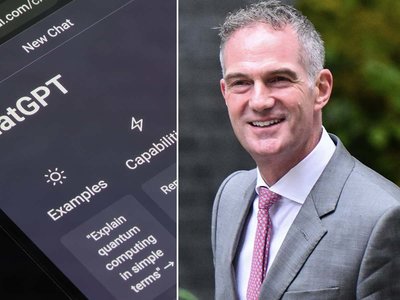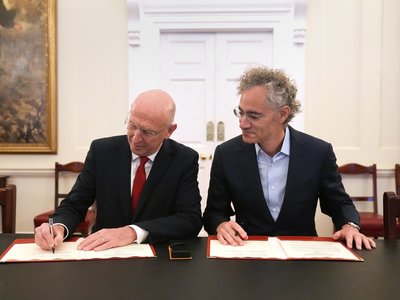Revealed: UK ministers were warned last year of risks of coronavirus pandemic
The detailed document warned that even a mild pandemic could cost tens of thousands of lives, and set out the must-have “capability requirements” to mitigate the risks to the country, as well as the potential damage of not doing so.
It comes as the UK’s hospital death toll from coronavirus heads towards 20,000. Less than a month ago, the medical director at NHS England, Prof Stephen Powis, said the country would “have done very well” to stay below this grim milestone.
Marked “official, sensitive”, the 2019 National Security Risk Assessment (NSRA) was signed off by Sir Patrick Vallance, the government’s chief scientific adviser, as well as a senior national security adviser to the prime minister whom the Guardian has been asked not to name.
The recommendations within it included the need to stockpile PPE (personal protective equipment), organise advanced purchase agreements for other essential kit, establish procedures for disease surveillance and contact tracing, and draw up plans to manage a surge in excess deaths.
Having plans for helping British nationals abroad and repatriating them to the UK was also flagged as a priority.
All of these areas have come under relentless scrutiny since the start of the coronavirus pandemic, with the government accused of being too slow to react to the crisis. It is now under sustained pressure to provide answers about what was done nationally and locally to provide the support that planners have long called for, amid growing fears ministers were “caught out” by the crisis and have been playing catchup ever since.
The Cabinet Office document, which runs to more than 600 pages, not only analysed the risk of a viral flu pandemic but also specifically addressed the potential for a coronavirus outbreak (the earlier Sars and Mers were both coronaviruses), though it regarded this as potentially much less damaging. In reality, the UK is dealing with a hybrid of the two, raising further questions about whether ministers were quick enough to recognise the dangers and were able to rely on whatever preparations were already in place.
Drawing on previous security assessments and health risk registers, the document implicitly warned ministers they could not afford to be complacent. “A novel pandemic virus could be both highly transmissible and highly virulent,” it said. “Therefore, pandemics significantly more serious than the reasonable worst case … are possible.”
The government declined to provide specific details of the preparations that had been made prior to the pandemic, but said it would be unfair to say they were “starting from scratch”, pointing to planning exercises carried out in recent years.
“This is an unprecedented global pandemic and we have taken the right steps at the right time to combat it, guided at all times by the best scientific advice,” a government spokesman said.
“The government has been proactive in implementing lessons learned around pandemic preparedness. This includes being ready with legislative proposals that could rapidly be tailored to what became the Coronavirus Act, plans to strengthen excess death planning, planning for recruitment and deployment of retired staff and volunteers, and guidance for stakeholders and sectors across government.”
But one source with knowledge of the Cabinet Office document said the UK had not properly focused on the pandemic threat, and had been caught flat-footed.
“The really frustrating thing is that there were plans. But over the last few years emergency planning has been focused on political drivers, like Brexit and flooding.
“There was a national plan for dealing with a pandemic that should have been implemented. But who took control of that? And who was responsible for making sure that plans were being made at a local level? The truth is, I am not sure anyone was doing this.”
The source added: “We have been paying for a third-party fire and theft insurance for a pandemic, not a comprehensive one. We have been caught out.”
The shadow Cabinet Office minister, Rachel Reeves, said the revelations were “alarming … and raised serious questions about the government’s planning and preparedness for a coronavirus-style pandemic”.
She demanded her opposite number, Michael Gove, give a statement to parliament on Monday to explain “whether this report was read and what actions were taken”.
The NSRA sets out a series of potential reasonable worst case scenarios (RWCS) for the spread of a flu-like viral pandemic, which emergency planning experts regard as the benchmark for its preparedness in the current crisis.
It also included predictions that offer insights into how planners believe a crisis like this current emergency might evolve.
The document said:
• A pandemic would play out in up to “three waves”, with each wave expected to last 15 weeks … “with the peak weeks occurring at weeks 6 and 7 in each wave”.
• 50% of the population would be infected and experience symptoms of pandemic influenza during the one or more waves. The actual number of people infected would be higher than this, as there would be a number of asymptomatic cases.
• A pandemic of moderate virulence could lead to 65,600 deaths.
• The potential cost to the UK could be £2.35tn.
• Even after the end of the pandemic, it is likely that it would take months or even years for health and social care services to recover.
• There would be significant public outrage over any perceived poor handling of the government’s preparations and response to the emergency.
The 2019 National Security Risk Assessment (NSRA) is a comprehensive planning document that sets out the risks facing the UK – and what is needed to prepare for them.
It was signed off by Sir Patrick Vallance, the government’s chief scientific adviser. Over 600 pages, it runs through dozens of potential threats – but an “influenza-type pandemic” is at the top of this worry list, as it has been for years. Here are some selected extracts…
Overview
Up to 50% of the UK population may fall ill, with up to 20% of people off work during the peak weeks, causing a significant impact on business continuity. Critical national infrastructure may also be affected during peak periods. There would be a huge surge in demand for health and social care services.Besides very severe levels of stress on the NHS, the level of excess deaths would stretch capacity within organisations involved in the management of deaths. This would be felt on a national scale, with local capacity likely to start to be overwhelmed during the peak of the pandemic. While not explicitly stated in every case, an influenza- type pandemic would probably compound the effects of the vast majority of risks in the NSRA, as all sectors would experience staffing pressures.
Response capability requirements
Procedures related to disease surveillance and early detection, plus any associated infrastructure, should be in place. Robust and tested arrangements for rapid scientific and clinical advice should similarly be set up.Local and national plans for management of excess deaths resulting from any mass casualty event should be present.
Local and national plans to deal with a surge in demand for health and social care services need to be accounted for.
There needs to be stockpiles of countermeasures and advanced purchase arrangements for those that cannot be acquired in advance.
Communication plans to encourage social distancing and good hygiene should be active. Sector resilience plans, including planning for absence of key workers, need enforcing.
Multiple waves
It is predicted that an influenza pandemic would come in multiple waves.
This means that recovery from one wave could be hampered by the arrival of a subsequent wave. Even after the end of a pandemic, it is likely that it would take months, or even years, for health and social care services to recover, although an exact timescale cannot be predicted. It is likely the economic impact would be felt for years.
The reasonable worst case scenario (RWCS) assumes that the pandemic will come in multiple waves (up to three), each approximately 15 weeks long.
For example, in the RWCS, 9,840,000 people would require assessment by health services (30% of those who are symptomatic), of which 1,312,000 people would require hospital treatment and 328,000 the highest level of critical care. Using the estimated UK population for 2016, this RWCS could result in 820,000 fatalities.
Besides very severe levels of stress on the NHS, the level of excess deaths would stretch capacity within organisations involved in the management of deaths, including coroners and burial services. This would be felt on a national scale, with local capacity likely to be overwhelmed during the peak of the pandemic.
• The pandemic would present in one or more waves. Each wave is expected to lasting 15 weeks, with the peak weeks occurring at weeks six and seven in each wave.
• Ffity per cent of the population would be infected and experience symptoms of pandemic influenza during the one or more waves. The actual number of people infected would be higher than this, as there would be a number of asymptomatic cases.
• A case fatality ratio of 2.5%, meaning 2.5% of those with symptoms could die as a result of the influenza virus. Four per cent of symptomatic patients would require hospital care, 25% of whom are expected to need the highest level of critical care (level three).
• Peak illness rates of about 10-12% (measured in new clinical cases per week as a proportion of the population) are expected in each of the weeks in the peak fortnight (weeks six and seven).
• Workplace absence rates for illness will be reaching 17-20% in the peak weeks.
On vaccines
There are no known markers that herald the start of a new pandemic. Based on most current vaccine technologies, it is likely to take at least four to six months after a novel virus has been identified and isolated for an effective pandemic influenza vaccine to become available from manufacturers in large quantity.This means that the first pandemic wave will not be vaccine-preventable; it will not be possible to contain a novel pandemic virus in its country of origin or on arrival in the UK.
The expectation must be that the virus will spread rapidly to the UK (a major global transport hub) and that any local measures taken to disrupt or reduce the spread are likely to have very limited or partial success at national level and cannot be relied on as a way to “buy time”.
The UK has an advanced purchase agreement for pandemic vaccine, which can be triggered in response to a pandemic threat. Even after the end of the pandemic it is likely that it would take months, or even years, for the health and social care services to recover, although an exact timescale cannot be predicted.
On deaths – moderate viral pandemic
This variation models a moderate pandemic, based on the 1957 and 1968 pandemics.The annual likelihood of a pandemic with the characteristics described below is 2%.
The specific assumptions of this scenario are listed below.
About 32% (21,320,000) of the population would be infected and experience symptoms of pandemic influenza.
A case fatality ratio of 0.2%, resulting in 65,600 deaths.
Of symptomatic patients, 0.55% (117,260) would require hospital care, 25% (29,315) of whom would be expected to require the highest level of critical care (level three).
Peak illness rates of about 6.5-8% (measured in new clinical cases per week as a proportion of the population) would be expected in each of the weeks in the peak fortnight (weeks six and seven). This scenario would still have a significant impact on health and social care systems as well as death management systems.
There would also be higher than usual absence from work.
On lockdown
Public health measures such as school closures and social distancing may be partially successful in delaying the peak of a pandemic wave by a few weeks at most, and might reduce the overall size of a pandemic wave.However these measures are disruptive, with known secondary consequences (eg closing schools would reduce the availability of healthcare workers), and the limited evidence available suggests that such measures have maximum effect when implemented early and simultaneously.
For the RWCS, it is assumed that schools have not been closed. Global travel, particularly commercial airlines, will have an impact on the spread of the disease. Although the strain was mild, the pandemic in 2009 showed that a rapid global spread was possible. However, evidence suggests that border control measures would be largely ineffective, because the duration of most international passenger flights is considerably shorter than the incubation period of the illness.
On behavioural impact/public outrage
The public outrage would likely be determined by the preparations and response undertaken by the government. Poor government handling of the situation would exacerbate the level of outrage significantly. There would be significant and widespread public outrage directed at the authorities given the very high numbers of fatalities and casualties within vulnerable groups. There would also be significant anger if vaccines, antivirals or other countermeasures were not perceived to be effective, evenly distributed or available as soon as practically possible, including when compared with other countries. The performance of the health and care system is likely to contribute to the public outrage, especially if provision of the remaining services is seen as unevenly distributed. There is also a risk public outrage may be directed at both foreign nations and nationals (who are seen as the “source” of the problem) for not preventing its spread or importing disease into the UK.Economic impact
Total cost: £2,354,738,558,884Economic impacts – confidence assessment.
To put that figure in context, £2.35tn is the equivalent of 131% of GDP.
It is worth noting that a large proportion (£1.5tn) of the economic impact comes from the social value of deaths.
Emerging infectious diseases, Response capability requirements
The capability requirements include disease surveillance systems, staff trained in enhanced infection control practices, adequate access to personalised protective equipment, adequate access to public health staff for contact tracing and follow-up, and excess death management capabilities (including potential infectious material). Decontamination services need to be available.Appropriate specialist healthcare services eg, high level-isolation units must be accessible, as well as appropriate facilities for quarantine.
















